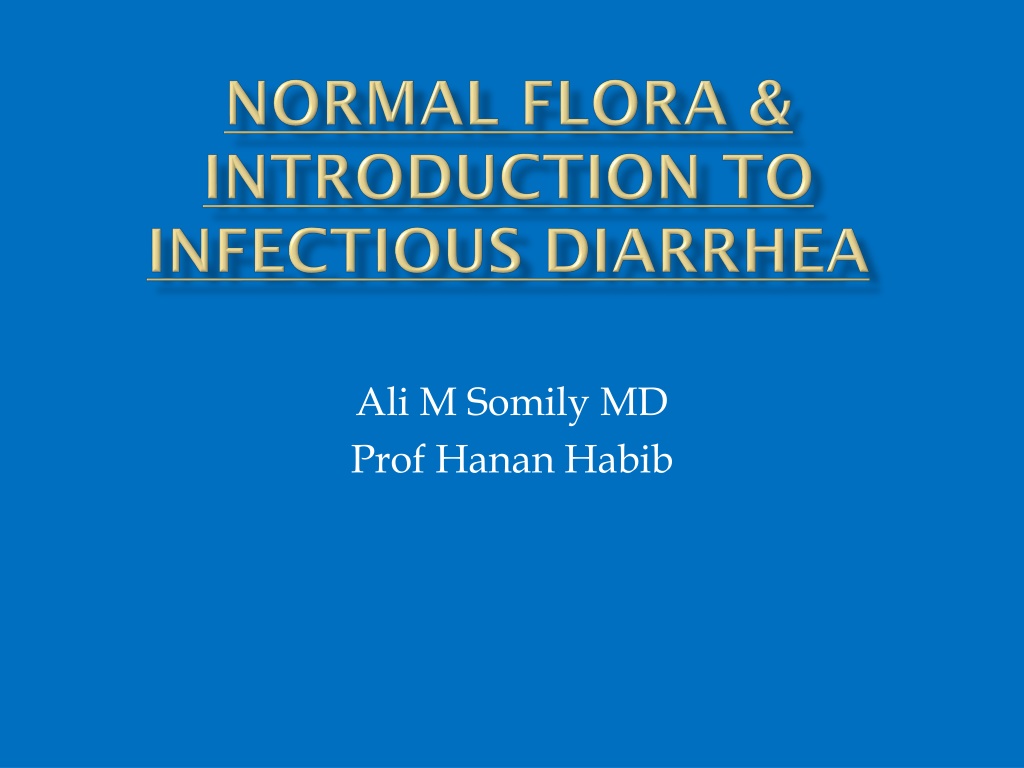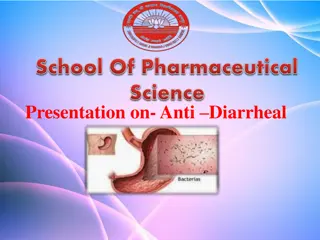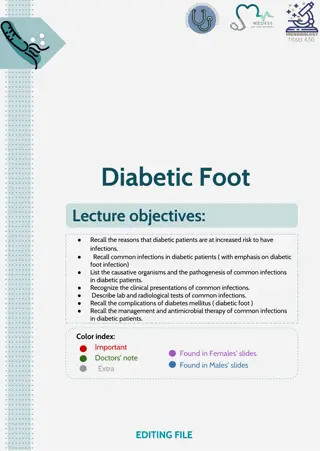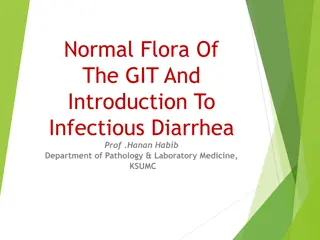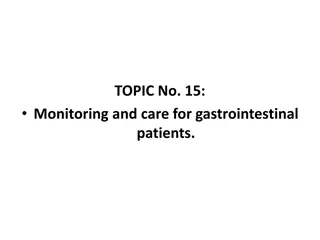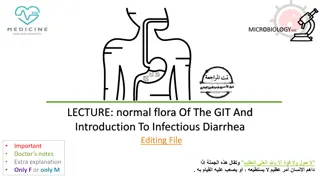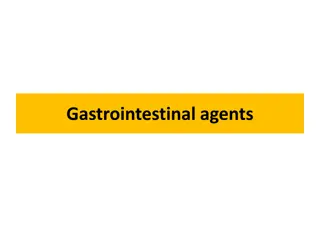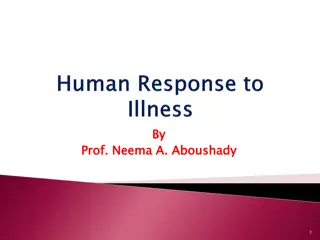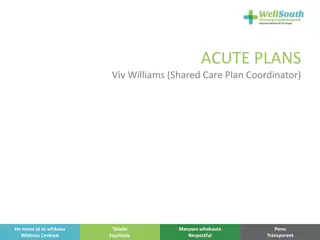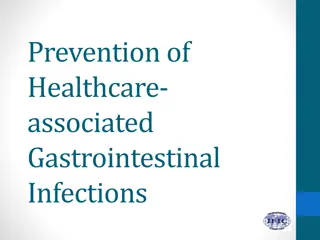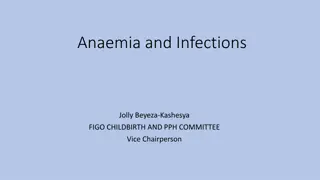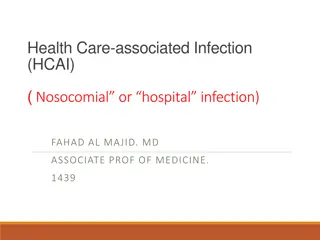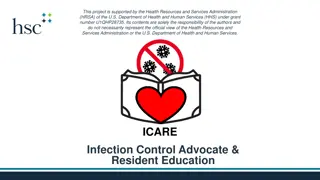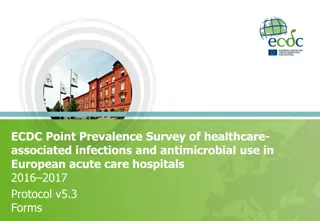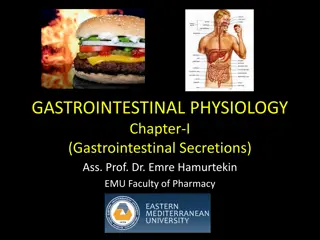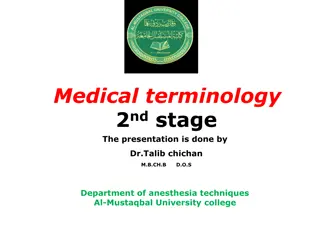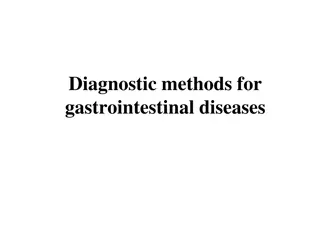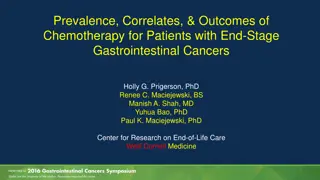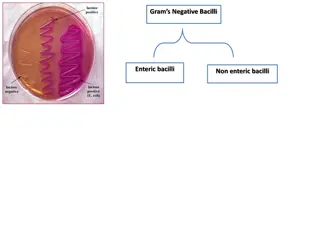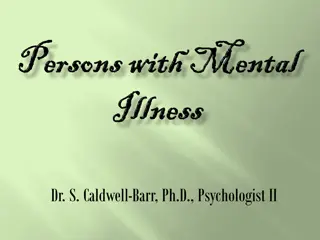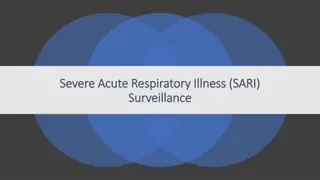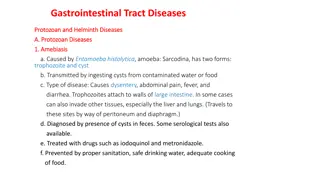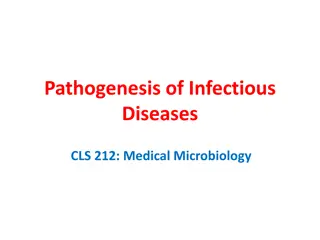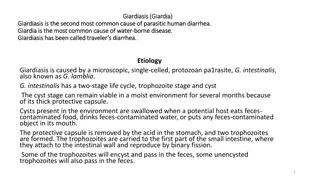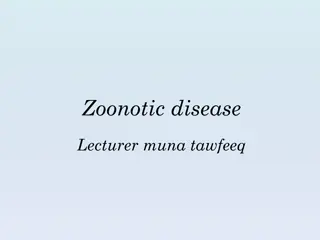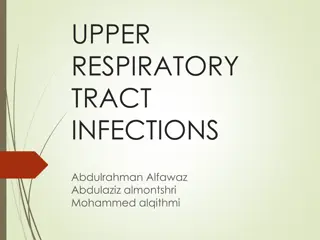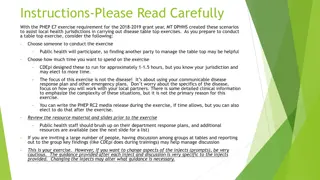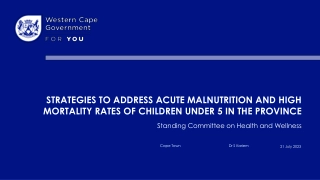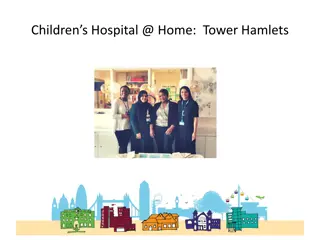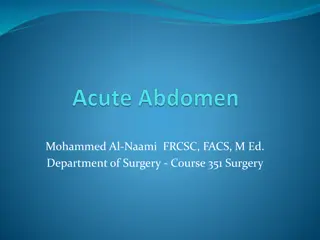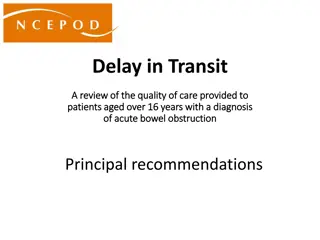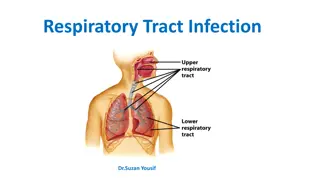Understanding Acute Diarrheal Illness and Gastrointestinal Infections
Acute diarrheal illness is a common issue globally, leading to significant morbidity and mortality. This lecture covers the types of acute diarrhea, host defenses, pathogens like E. coli, Campylobacter, and Yersinia, and their management. It also discusses microbiological diagnosis methods, food poisoning, travelers' diarrhea, and antibiotic-associated diarrhea. The content delves into the ecology of gut bacteria, aerobic and anaerobic species, and the distribution of bacteria in the gastrointestinal tract.
Download Presentation

Please find below an Image/Link to download the presentation.
The content on the website is provided AS IS for your information and personal use only. It may not be sold, licensed, or shared on other websites without obtaining consent from the author. Download presentation by click this link. If you encounter any issues during the download, it is possible that the publisher has removed the file from their server.
E N D
Presentation Transcript
Ali M Somily MD Prof Hanan Habib
By the end of this lecture the student should be able to: Define and recognize the various types of acute diarrheal illness Describe the epidemiology the host defenses in preventing the gastrointestinal infection Explain pathogenesis by which Escherichia coli campylobacter and yersinia and their management Discuss the microbiological methods used for diagnosis of each of the bacterial agents including microscopy, selective media for maximal recovery Describe the pathogens, risk factors, clinical presentation and prevention of food poisoning travelers and antibiotic associated diarrhea. Name the etiological agents causing food poisoning and their clinical presentation
Acute diarrheal illness is one of the most common problems evaluated by clinicians. A major cause of morbidity and mortality world wide. Most of healthy people have mild illness but other might develop serious squeals so it is important to identify those individuals who require early treatment.
Ecology Birth: sterile Breast-fed Bifidobacteria species Switch to cow s milk Enteric, bacteroides, enterococci, lactobacilli and clostridia Switch to solid food Microflora similar to parents
Primarily anaerobic Facultative aerobes deplete oxygen Adult excretes 3x1013 bacteria/day 25%-35% of fecal mass = bacteria GI ecology varies Esophagus saliva ,food Stomach harsh 10 Small intestine (103-108) Large intestine 109-1011/ml >350 species E. coli = 0.1% of total population
Location (adult) Bacteria/gram contents duodenum 103-106 jejunum and ileum 105-108 cecum and transverse colon sigmoid colon and rectum 108-1010 1011
Stool weight in excess of 200 gm/day 3 or more loose or watery stools/day Alteration in normal bowel movement characterized by decreased consistency and increased frequency Less than 14 days in duration
Viral: 70-80% of infectious diarrhea in developed countries Bacterial: 10-20% of infectious diarrhea but responsible for most cases of severe diarrhea Protozoan: less than 10%
1.2-1.9 episodes per person annually in the general population 2.4 episodes per child >3 years old annually 5 episodes per year for children <3 years old and in daycare Seasonal peak in the winter
1. Infectious diarrhea- viral Bacterial organism. Campylobcator, Shigella, Solmnella, Yersinea, Cholera and E.coli 2. Food poisoning:Staphylococcus, Clostridium perferinges, Bacillus. 3. Traveler diarrhea - Enterotoxogenic E-coli IP >1 day last 3 4. Antibiotic associated diarrhea-Clostridium defficile
Food from restaurant Family member with Gastrointestinal symptoms Recent travel to developing countries Patient underlying illness and mediation( Stomach acidity cyst, spores) Abnormal peristalsis Low Immunoglobulin IgA Antibiotics decrease the normal flora to less 1012 Median infective dose (ID50)
Enterotoxin mediated Lack of pus in the stool (no invasion) Lack of fever Rapid onset preformed toxin<12 hr Small intestine Vomiting ,non-bloody diarrhea, abdominal cramp Vibreo cholero, Staphylococcus aureus, Clostridium perfringens and Bacillus cereus Other viral and some parasitic infection
Invasive:- Extension to lymph nodes Incubation period 1-3 days Dysentery syndrome- gross blood and mucous EHEC bloody diarrhea E.histolytica 1-3 wk Pus and blood in the stool Fever due to inflammation Shigella, Solmonella spp, Campylobacter, some E- coli and Endameba histolytica Affect colonic mucosal surface of the bowel
Salmonella enterica is the common cause of food poisoning in Saudi Arabia. Salmonella typhi transmitted through human faeces. Shiegella causes local Gastrointestinal invasion and bacterimia less common in normal host.
Family Campylobacteraceae Genus arcobacter Epidemiology Source: poultry, birds, dog , cat, water, milk, meat, person to person can occurs
IP 2-6 days Abdominal cramp, bloody diarrhea , nausea and vomiting are rare Self limiting 2-6 Day Chronic carrier GB and Reactive arthritis
Laboratory Transport media Cary Blair CAMPY BAP contain antibiotics Incubate in 5%O210%CO285%N @ 42 C except C.fetus 37 C Gram stain/culture biochemical/Serology Treatment: Ciprofloxacin, Erythromycin or Tetracycline
Only about 10 -15% of strains of E. coli associated with diarrhea. Based on virulence factors, clinical manifestation, epidemiology and different O and H serotype. There are five major categories of diarrheagenic E.coli: Types of E. coli diarrhea Enterotoxigenic E. coli (E T E C) Enteropathogenic E. coli (E P E C) Enteroinvasive E. coli (E I E C) Enterohaemorrhagic E. coli (E H E C ) Enteroadherent E.coli (EAEC) 1. 2. 3. 4. 5.
Major cause of traveler's diarrhea in infant and adult in developing countries from contaminated food and water It has infective dose 106-1010 Has heat-labile toxin (LT) and heat-stable toxin (ST) each has two fragment (A and B) LT leads to accumulation of CGMP, which lead to hyper secretion Symptoms watery diarrhea, abdominal cramps and some time vomiting No routine diagnostic method.
Produce dysentery (Penetration, invasion and distraction) Similar to Shigella spp (Non motile, LNF) Fecal oral route Fever, severe abd. cramp, malaise and watery diarrhea Infective dose106 Diagnosis Sereny test and DNA probes.
Infantile diarrhea Outbreak in hospital nurseries and day- care centers Low grade fever, malaise, vomiting and diarrhea Stool mucous but no blood.
O157H7 and Non O157H7 Hemorrhagic diarrhea, colitis and hemolytic uremic syndrome (HUS)= Platelet count, hemolytic anemia and kidney failure Undercooked hamburgers, unpasteurized dairy products, apple cider, cookie dough Bloody diarrhea, low grade fever and stool has no leucocytes Fetal disease in young and elderly persons in nursing homes Cytotoxin =vertoxin and vertoxin Similar to Stx1 (shigotoxin I&II) E.coli other than 0157H7 can cause HUS Diagnosis by culture on SMAC, MUG test , Vertoxin detection by immunological test or PCR
Pediatric Diarrheal Disease Adhering to the surface of the intestinal mucosa Aggregative stacked brick Watery diarrhea, vomiting, dehydration and abdominal pain Two or more weeks
Mesenteric lymphadenitis in children and septicemia in immunocompramised hosts Common in Europe, USA, Canada and cat, dog, swine (chitterlings) Survive cold temperatures and associated with transfusion of packed red blood cells. Presented with enteritis, arthritis and erythema nodosum Generalize infection in 1'C adult children 1-5 yrs usually mild but in old children adult mimic appendicitis Growth at 25 c-30 c media Cefsulodin-Igrasan- Novabiacin (CIN)
Antibiotic associated diarrhea Transmit from person to person via Fecal-Oral route Have been cultured from in animate hospital surfaces Disruption of the indigenous bacterial flora of the colon Produce toxin A and B that can bind to surface epithelial cell receptors leading to inflammation mucosal injury and diarrhea
Patient Presents with fever, leukocytosis, abdominal pain and diarrhea Pseudomembrane can result (neutrophils, fibrin, and cellular debris in the colonic mucosa) and toxic megacolon Diagnosis, toxin detection by EIA Treatment Metronidazole Vancomycin and supportive treatment
Selected Clinical and Epidemiologic Characteristics of Typical Illness Caused By Common Foodborne Pathogens* Pathogens Typical Incubation Period 1-3 1week Duration Typical Clinical Presentation Assorted Foods 1-3 Days 4-7 Days Undercooked eggs or poultry, Reptiles Salmonella species Gastroenteritis 2-6 Days 2-6 Days Gastroenteritis Undercooked Campylobacter jejuni poultry, unpasteurized dairy products 1-3 Days 3-7 Days Gastroenteritis Many foods E. coli, Enterotoxigenic Shigella species 4-7 Days 1-3 Days Gastroenteritis Egg salad
Food Poisoning pathogens (Toxin mediated ) 6-18 hour Gastroenteritis Vomiting, Gastroenteritis, particularly nausea Fried rice, meats <24 hour Bacillus cereus 6-18 hour Meats, potato & pork, unpasteurized dairy products. Beef, poultry 1-2 Days Staphylococcus aureus 6-24 hour Gastroenteritis and abdominal cramps Days -weeks Clostridium perferinges
Other pathogens acquired by food 1-2 Days 1-3 weeks Gastroenteritis, appendicitis-like syndrome Undercooked pork, unpasteurized dairy products. Deli meat, hotdogs, unpasteurized dairy products Yersinia enterocolitica Gastroenteritis, meningitis abortion 2-6 weeks Variable Listeria monocytogenes
